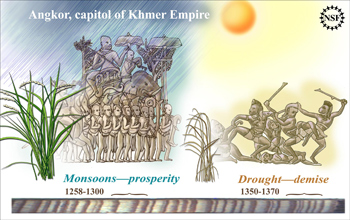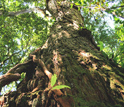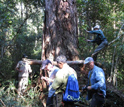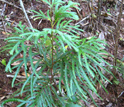News Release 10-048
Climate Helped Bring Angkor to Its Knees
Tree ring record reveals abrupt end to empire

In wet times, Angkor, the Khmer capitol thrived. Dry times coincided with its demise.
March 29, 2010
This material is available primarily for archival purposes. Telephone numbers or other contact information may be out of date; please see current contact information at media contacts.
Throughout written history there have been many abrupt ends to empires and civilizations that have little explanation. Political climates deteriorate, passions rise, revolts happen and the next thing you know--the culture is a thing of the past relegated to a short chapter in a textbook.
The natural world leaves a record in the form of tree rings, which can be read like a very detailed book, covering a long period of human history. Now a team of researchers has correlated the demise of Angkor, the capitol of the Khmer Empire in Cambodia, with a decades-long drought interspersed with intense monsoons in the 14th and 15th centuries.
Brendan Buckley of Lamont-Doherty Earth Observatory of Columbia University and his colleagues have put together a high-resolution record of periods of drought and moisture in Southeast Asia that is over three quarters of a millennium long from 1250 to 2008 AD. Their research was funded by the National Science Foundation's Paleoclimate Program, which is part of the directorate for geosciences.
Just as satellite photos do--large sets of information like this tree ring data bring into focus patterns and phenomena that are larger than one lifetime. In fact they are on the scale of civilizations.
A look at tree ring data, and an analysis of rain, drought and temperature can show a remarkable link from climate in the environment to climate in the king's court. And this has been shown to be true for the enigmatic demise of Angkor, an empire that stood strong from the 9th to 13th centuries.
Angkor was a city that relied heavily on water. The National Science Foundation-funded work of Buckley and his colleagues reveals that the mid- to late 1300's experienced persistently dry conditions that spanned decades, followed by several years of severe wetness that may have caused damage to the city's infrastructure. Afterwards, a shorter but more severe drought in the early 1400's may have been more than this urban complex could handle.
Bringing insights such as these into focus in the 21st century, there is a sense of urgency in interpreting what the natural world is telling us. The very cypress trees (Fokienia hodginsii) that allow the long-range glimpse backwards are becoming more and more rare as their wood is harvested for the illicit timber trade. The highlands of Vietnam and Laos are home to some of the region's most diverse biota, and are under threat of over-exploitation.
-NSF-
-
A millennial aged Fokienia tree in Vietnam.
Credit and Larger Version -
Researchers taking a tree core from Fokienia tree in Vietnam.
Credit and Larger Version -
Fokienia tree seedling.
Credit and Larger Version
Media Contacts
Cheryl L. Dybas, NSF, (703) 292-7734, email: cdybas@nsf.gov
Kevin Krajick, The Earth Institute, Columbia University, (212) 854-9729, email: kkrajick@ei.columbia.edu
Kim Martineau, The Earth Institute, Columbia University, (845) 365-8708, email: kmartineau@ei.columbia.edu
Principal Investigators
Brendan M. Buckley, Lamont-Doherty Earth Observatory of Columbia University, (845) 365 8782, email: bmb@ldeo.columbia.edu
Related Websites
Tree Ring Video, The Earth Institute, Columbia University: http://www.earth.columbia.edu/videos/watch/108
The U.S. National Science Foundation propels the nation forward by advancing fundamental research in all fields of science and engineering. NSF supports research and people by providing facilities, instruments and funding to support their ingenuity and sustain the U.S. as a global leader in research and innovation. With a fiscal year 2023 budget of $9.5 billion, NSF funds reach all 50 states through grants to nearly 2,000 colleges, universities and institutions. Each year, NSF receives more than 40,000 competitive proposals and makes about 11,000 new awards. Those awards include support for cooperative research with industry, Arctic and Antarctic research and operations, and U.S. participation in international scientific efforts.
Connect with us online
NSF website: nsf.gov
NSF News: nsf.gov/news
For News Media: nsf.gov/news/newsroom
Statistics: nsf.gov/statistics/
Awards database: nsf.gov/awardsearch/
Follow us on social
Twitter: twitter.com/NSF
Facebook: facebook.com/US.NSF
Instagram: instagram.com/nsfgov



